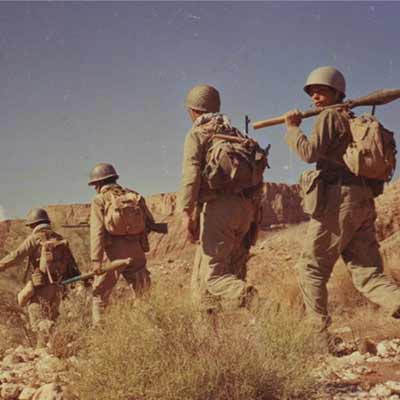Battles
Operation Qader
Leila Khorasanifar
204 دورہ
Operation Qader was carried out on July 14, 1985, with the code-name “Ya Sahib al-Zaman (as)” under the command of Ali Sayyad Shirazi, the then-Commander of the Iranian Army Ground Forces. It took place in Oshnavieh, Iran, as well as Erbil and Sidekan, Iraq. It had three main phases, namely Qader 1, Qader 2, and Qader 3, which continued until September 12, 1985, followed by a defensive phase that was launched on October 9, 1985.
Following Operation Badr (March 11, 1985), the bombing of Iranian residential areas intensified. In such a situation, carrying out limited operations was a priority for Iran to undermine enemy morale while boosting that of Iranian forces, maintain initiative on the battlefield, buy time to strengthen Iranian military structure, and secure an opportunity to select and prepare the primary operational zone.
Accordingly, the Islamic Revolutionary Guard Corps (IRGC) proposed several areas for launching an operation, including Sidekan, the preparation of which was entrusted to the Hamzeh Seyyed al-Shuhada Headquarters.[1] Sidekan had long been a stronghold for Barzani forces who opposed the Ba'athist regime of Iraq.[2] At the time, Barzani’s sons were leading the Kurdistan Democratic Party of Iraq and controlled the region.[3] The Iranian forces were going to seize the Hassan-Beik, Qalandar, and Sarpiran Heights, thereby overseeing the cities of Sidekan and Margesour and capturing the Hassan-Ali Beik Pass, which was of great military and strategic importance. The objective of the operation was to establish a foothold for adopting irregular warfare tactics inside Iraq.
After Operation Badr and considering the developments of the military dynamics of the war, the collaboration between the IRGC and the Army underwent significant changes. It was decided that both organizations would submit their operational plans to the Supreme Command of War, specifying the level of assistance required from the other. Despite the IRGC’s extensive activities in the Sidekan, in June 1985, the Army was officially tasked with carrying out reconnaissance missions and attacks with the Special Martyrs’ Brigade under its command.[4]
Therefore, with the support of some IRGC units, the Army initiated Operation Qader on July 14, 1985, aiming to seize key strategic heights, cut enemy logistical supply lines and communications, destroy enemy forces, liberate parts of Iraqi territory, and advance towards the main routes. Ali Sayyad Shirazi led the operation, which was conducted in three primary and one defensive phases.[5]
Before the operation, Sayyad Shirazi held a meeting with Masoud Barzani and his commanders, briefing them on the operation and asking them to inform their forces. Masoud Barzani said that all the civilians living in the operational area were with him and assured that if the area were liberated, he would help maintain its stability.[6]
The first phase of Operation Qader, known as Qader 1, began on July 14, 1985.[7] Iranian forces launched a well-organized offensive 30 kilometers deep into the mountainous regions of Iraq through Kalashin, a border area near Oshnavieh, surprising Saddam’s army, destroying several enemy equipment, and capturing some soldiers as war prisoners. The Iranians went on to take control of Sarpeleh Heights and part of Goshband Heights but had to retreat from Goshband due to heavy Iraqi pressure and established a defensive position at Hesardast Heights.[8]
In Qader 2, the Quds Brigade advanced towards the Sarkhiyat and Sarsagar Heights on July 28, 1985. The following day, Iranians managed to clear several enemy positions, and later on, the Sarhoveizeh, Sarpeleh, and Oshnavieh Heights were captured. However, due to a heavy Iraqi counterattack, the Iranian forces eventually had to withdraw.[9]
On September 8, 1985, Iraq launched a massive counteroffensive on the Sarkhiyat front, recapturing the area after hours of intense fighting. On the same day, Qader 3 was carried out in the Borebouk Heights, the northernmost border area between Iran and Iraq. The 8th Najaf Ashraf Division of the IRGC, the Airborne Brigade, the 23rd NOHED Division, the Special Martyrs’ Brigade, and the 1st Brigade of the 77th Division engaged in this phase of the operation and successfully advanced 45 square kilometers into Iraqi territory. However, due to intense Iraqi counterattacks, Iranian forces had to retreat the following day. On September 12, 1985, Operation Qader 3 ended without achieving the desired outcomes.[10]
Following the three phases, the defensive phase began, and the whole operation was ultimately finished on November 13, 1985.[11]
During Operation Qader, the Iranian forces captured the Hesarvast, Barbazinrost, Kargazin, Lolan, Gardeshvan, and Bashkin Heights, advancing 35 kilometers into Iraqi territory. In addition, a large area of Sidekan and Diana, along with over 10 villages and towns, came within effective Iranian artillery range. However, the captured positions were not fully secured. Although Iranian forces achieved some objectives in each phase of the operation, factors such as enemy counterattacks prevented a decisive victory. Iraqi casualties included 2,000 dead, 3,000 wounded, and 30 captured. Moreover, 6 aircraft, 3 helicopters, 22 armored and engineering military vehicles, 274 light and heavy vehicles, and 25 artillery pieces were destroyed.[12] Also, Iranian casualties amounted to 178 martyrs, 428 wounded, and 619 missing.[13] One of the key Army commanders and strategists, Hassan Abshenasan, who developed the plan of the operation, was martyred on September 30, 1985.[14]
[1] Faslnameh-ye Tarikh-e Jang (Journal of War History), Markaz-e Motaleat va Tahqiqat-e Jang, Year 3, No. 8, Autumn 1373, Pp. 21–23.
[2] Alaei, Hussain, Tarikh-e Tahilii-ye Jang-e Iran va Araq (Analytical History of the Iran-Iraq War), Vol. 2, Tehran: Marz-o-Boom, 1395, p. 131.
[3] Entesar, Nader, translated by Erfan Qanei-Fard, Siyasat-e Kordha dar Khor-e Mianeh (Kurdish Politics in Khor-e Mianeh), Tehran: Elm, 1390, p. 263.
[4] Faslnameh-ye Tarikh-e Jang (Tarikh-e Jang Quarterly), Pp. 23 and 24.
[5] Kamiab, Muhammad, Amaliyat-e Qader: Tir-Mah ta Aban-Mah 1364, Mantaqeh-ye Amaliyati-ye Shomal-Gharb (Operation Qader: July to November 1985, Northwestern Operational Zone), Tehran: Iran Sabz, 1392, Pp 24 and 38.
[6] Amaliyat-e Qader va Modiriyat-e Mostaqel-e Artesh dar Jang (Operation Qader and the Independent Management of the Army in the War), Paygah-e Ettelarasani-ye Pajouheshkadeh-ye Oloum va Maaref-e Defa-e Muqaddas, p. 28; Kamiab, Muhammad, Amaliyat-e Qader: Tir-Mah ta Aban-Mah 1364, Mantaqeh-ye Amaliyati-ye Shomal-Gharb (Operation Qader: July to November 1985, Northwestern Operational Zone), p. 25.
[7] Ibid., p. 38.
[8] Izadi, Mostafa, Esteki, Javad, Yaran, Masoud, Tarikh-e Bist-Saleh-ye Pasdari az Enqelab-e Eslami dar Gharb-e Keshvar (Twenty-Year History of Defending the Islamic Revolution in the Western Region), Vol. 5: Tahajom-e Araq va Moqabeleh ba Motajavezain (Iraq's Invasion and Confronting the Aggressors), Tehran: Daneshgah-e Emam Hussain (as), Daneshkadeh va Pajouheshkadeh-ye Farmandehi va Setad va Oloum-e Defai, Markaz-e Motaleat va Tahqiqat-e Toseeh-ye Amniat-e Paydar, 1387, p. 323.
[9] Amaliyat-e Qader va Modiriyat-e Mostaqel-e Artesh dar Jang (Operation Qader and the Independent Management of the Army in the War), Pp. 36–38.
[10] Izadi, Mostafa, Esteki, Javad, Yaran, Masoud, Tarikh-e Bist-Saleh-ye Pasdari az Enqelab-e Eslami dar Gharb-e Keshvar (Twenty-Year History of Defending the Islamic Revolution in the Western Region), Vol. 5, Pp. 323 and 324.
[11] Kamiab, Muhammad, Amaliyat-e Qader: Tir-Mah ta Aban-Mah 1364, Mantaqeh-ye Amaliyati-ye Shomal-Gharb (Operation Qader: July to November 1985, Northwestern Operational Zone), p. 262.
[12] Jafari, Mojtabi, Atlas-e Nabardha-ye Mandegar: Amaliyat-e Niroha-ye Zamini dar Hasht Sal Defa-e Muqaddas, Shahrivar-Mah 1359 ta Mordad-Mah 1367 (Atlas of Memorable Battles: Army Ground Forces Operations During the Eight Years of Sacred Defense, September 1980 to August 1988), Tehran: Sureh Sabz, 35th Edition, 1383, Pp. 110 and 112.
[13] Izadi, Mostafa, Esteki, Javad, Yaran, Masoud, Tarikh-e Bist-Saleh-ye Pasdari az Enqelab-e Eslami dar Gharb-e Keshvar (Twenty-Year History of Defending the Islamic Revolution in the Western Region), Vol. 5, p. 324.
[14] Edalatkhah, Fariborz, Zendeginameh-ye Shahid Sardar Lashkar Hassan Abshenasan (Biography of Martyr Brigadier General Hassan Abshenasan), Tehran: Sazman-e Hefz-e Asar va Nashr-e Arzesh-ha-ye Defa-e Muqaddas-e Artesh-e Jomhouri-ye Eslami-ye Iran, Entesharat-e Atashbar, 1395, p. 66.



